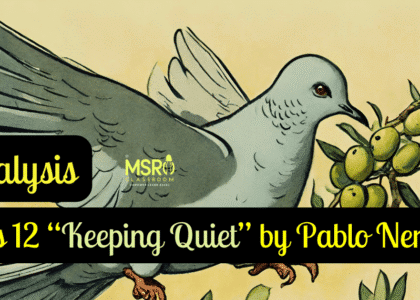Poem 3, John Keats’ ‘A Thing of Beauty’ Summary, Theme, Line-by-Line Explanation, Textbook Exercises, Extra Questions with Extract-Based Questions.
Poem 3- A Thing Of Beauty by John Keats:
John Keats
John Keats (1795–1821) was a revered English Romantic poet whose works epitomised the era’s emotional intensity and aesthetic beauty. His poetry showcased an exquisite fusion of vivid imagery, sensual language, and profound emotion.

Table of Contents
Next on Flamingo: Poem 4-A Roadside Stand, Poem 5-Aunt Jennifer’s Tigers
Supplementary Reader: Class 12- ‘Vistas‘
Source of the poem ‘A Thing of Beauty’:
In Greek mythology, Endymion, a beautiful young shepherd, was enchanted by the vision of Cynthia, the Moon Goddess. The Goddess Cynthia so enamoured him that he decided to wander away through the forest to seek her. Keats wrote his poem, ‘Endymion: A Poetic Romance,’ based on this mythology. The poem “A Thing of Beauty” (initial 24 lines) is an excerpt from “Endymion.”
Vocabulary/Glossary:
| Band: A flat strip or loop used as a fastener or decoration. Bind: To fasten securely with a band or cord. Boon: Something helpful or beneficial. Bower: A shady spot under trees. Brake: A dense growth of shrubs. Covert: A thick cover or hiding place. Dearth: A scarcity of something. Despondence: Low spirits from loss of hope. Dooms: Fates or destinies. Grandeur: Impressive splendor or style. Immortal: Living forever; never dying. Mighty: Possessing great power or strength. Morrow: The following day; tomorrow. Noble: Possessing high moral qualities. O’er-darkened: Made dark. Pall: A cloth over a coffin or tomb. Rills: Small, narrow streams. Sprouting: Beginning to grow from a seed. Sorrow: Deep distress from loss or misfortune. Wreathing: Twisting or entwining. |
Summary “A Thing of Beauty”:
“A Thing of Beauty” by John Keats celebrates beauty’s enduring and uplifting power. The poem portrays beauty as a source of eternal joy that grows with time and never fades away.
It provides solace and tranquillity as a refuge for pleasant dreams, good health, and calm breathing. Keats urges people to embrace beauty daily, forming a strong connection with the Earth.
Despite challenges and humanity’s flaws, beauty brightens spirits. Natural elements like the sun, moon, trees, and daffodils exemplify this revitalising beauty.
The poem also highlights stories and legends that inspire, nourishing the human spirit like a divine source of refreshment. In essence, it emphasises the lasting significance of beauty in providing eternal joy and inspiration to human life.

SHOP: MSRO SMART NOTES: Class 12 English Literature
Central Idea: A Thing of Beauty:
‘A Thing of Beauty’ by John Keats celebrates beauty’s everlasting and uplifting power. Keats asserts that beauty brings perpetual joy and tranquillity to humanity.
It never fades but grows loveliness over time, offering a peaceful refuge for pleasant dreams and good health. Despite life’s challenges and darkness, beauty remains a constant source of solace, connecting individuals to the Earth and inspiring noble qualities.
Natural elements like the sun, moon, trees, and daffodils exemplify this enduring beauty, as do stories of grandeur and inspiration. Keats portrays beauty as an infinite source of refreshment, pouring divine nourishment onto humanity, ultimately conveying the message of beauty’s eternal significance in enriching and inspiring human life.
Analysis and Explanation of ‘A Thing of Beauty’ for Auditory Learners:
Duration: 17 minutes
Chapters/time stamps with English subtitles are available.
Line-by-Line Explanation of ‘A Thing of Beauty’:
Lines 1-4:
“A thing of beauty for ever:
Its loveliness increases; it will never
Pass into nothingness; but will keep
A bower quithe et for us, and a sleep”
The poem begins with a bold statement about the everlasting nature of beauty. Keats asserts that beauty brings enduring joy, and its charm grows with time. He uses the metaphor of a “bower,” a sheltered place in a garden, to convey that beauty provides a serene and comforting refuge for individuals. The mention of “sleep” suggests the rest and peacefulness that beauty imparts.
- Keats begins with a bold assertion about beauty’s enduring/everlasting nature. He declares that beauty exists eternally, without fading or diminishing over time.
- Keats continues by stating that the attractiveness or charm of beauty only grows with time. The line emphasises that beauty remains constant and becomes more captivating as time passes.
- Keats refutes the notion that beauty will eventually fade away into nothingness. Instead, he asserts that beauty will persist and endure indefinitely.
- Keats employs the metaphor of a “bower,” a tranquil and sheltered spot in a garden, to represent the serene refuge that beauty provides for individuals. The mention of “sleep” suggests the restful and peaceful state that beauty induces/generates in those who experience it.
Lines 5-8:
“Full of sweet dreams, and health, and quiet breathing.
Therefore, on every morrow, are we wreathing
A flowery band to bind us to the earth,
Spite of despondence, of the inhuman dearth”
- Keats begins by describing the positive effects of beauty, including pleasant dreams, good health, and tranquil breathing. The line emphasises beauty’s soothing and rejuvenating nature on the human spirit and physical well-being.
- Keats suggests that because of the beneficial effects of beauty, people engage in “wreathing” or adorning themselves with a “flowery band” every day. The metaphorical imagery conveys that humans naturally seek out and celebrate beauty to connect with the world around them.
- The “flowery band” symbolises humanity’s connection to the natural world and its beauty. By adorning themselves with this metaphorical band, people affirm their bond with the earth and the beauty it offers.
- Despite feelings of despair/despondency or hopelessness and the perceived lack of noble qualities (“inhuman dearth”) in the world, Keats suggests that humans are still compelled to seek out and appreciate beauty. The line highlights the resilience of the human spirit and its enduring pursuit of beauty as a source of solace and connection.
Lines 9-12:
“Of noble natures, of the gloomy days,
Of all the unhealthy and o’er-darkened ways
Made for searching: yes, in spite of all,
Some shape of beauty moves away the pall”
Here, Keats acknowledges the challenges faced by humanity, including the scarcity of virtuous individuals and the presence of gloomy days and negative experiences. Despite these hardships, beauty is a palliative (soothing, comforting presence), alleviating the heaviness and darkness that can overshadow our lives. The phrase “moves away the pall” suggests that beauty lifts the veil of sorrow and brings brightness.
- Keats begins by acknowledging the existence of noble and virtuous individuals and the presence of gloomy or dark days in human experience. The line suggests that even among the challenges and negativity in life, there are still noble qualities and virtues present in certain individuals.
- Keats expands on the difficulties faced by humanity, including unhealthy behaviours and ways of living that are excessively dark or negative. The line emphasises the pervasive nature of these challenges in human society.
- Keats suggests that these challenges are opportunities for searching or seeking something greater. Despite the hardships and obstacles encountered, there is an implicit call to persevere and continue searching for meaning and beauty in life.
- Keats asserts that despite the darkness and difficulties, beauty can alleviate or dispel the pall, or heavy covering, of sorrow and despair. The phrase “some shape of beauty” implies that beauty can take various forms, whether in nature, art, relationships, or other aspects of life. This line highlights beauty’s transformative and uplifting nature, offering hope and comfort amidst life’s trials.
Lines 13-14:
“From our dark spirits. Such the sun, the moon,
Trees old and young, sprouting a shady boon”
Keats lists the sun, the moon, and trees as examples of beautiful elements that uplift the human spirit. These natural symbols of beauty and cyclical renewal counteract the darkness within human hearts.
- “From our dark spirits.“: Keats begins by suggesting that the elements can uplift or dispel the darkness within human spirits. This darkness may refer to feelings of despair, sadness, or negativity.
- “Such the sun, the moon,”: Keats lists the sun and the moon as examples of the beautiful elements he believes can dispel the darkness within human spirits. These celestial bodies are often associated with light, guidance, and cyclical renewal.
- “Trees old and young,”: Keats continues his list by mentioning old and young trees. Trees represent the natural world and its cyclical growth, death, and regeneration. Their presence in the poem suggests a connection between nature and the human spirit.
- “Sprouting a shady boon”: Keats concludes by describing trees as “sprouting a shady boon.” The phrase suggests trees provide shade, a refuge from the sun’s harshness, and a “boon,” or a beneficial gift. The image reinforces the idea that nature offers comfort and rejuvenation to the human spirit, even in its darkest moments.
Lines 15-18:
“For simple sheep; and such are daffodils
With the green world they live in; and clear rills
That for themselves a cooling covert make
‘Gainst the hot season; the mid forest brake,”
- The poet begins by stating that even simple and humble creatures like sheep and flowers like daffodils contribute to the beauty of the world.
- The poet continues by describing how daffodils thrive in the lush, green environment of their home, and alongside them are clear streams or brooks (rills) that flow through this green landscape.
- The clear streams create a shelter or refuge (covert) for themselves, where they flow and form cool, shaded areas, providing relief from the heat.
- These streams create a natural defence (‘gainst = against) against the heat of the hot season. The “mid forest brake” refers to a clearing or open space in the middle of a forest, suggesting a calm and inviting oasis within the woodland.
Lines 19-20:
“Rich with a sprinkling of fair musk-rose blooms:
And such too is the grandeur of the dooms”
Keats continues to celebrate the beauty of nature, describing the forest as adorned with delicate musk-rose flowers. He then transitions to the concept of “dooms,” which refers to grand and legendary past stories in this context.
- Keats describes the forest as abundant and adorned with delicate musk-rose flowers. “Rich” suggests a sense of luxury or abundance, while “sprinkling” implies a scattering or profusion of these beautiful blooms. “Fair musk-rose blooms” emphasises these flowers’ delicate and attractive nature, adding to the imagery of natural beauty.
- Keats compares the beauty of the forest adorned with musk-rose blooms and the grandeur of something called “dooms.” The term “dooms” likely alludes to significant or legendary events from the past, possibly with connotations of fate, destiny, or historical importance. “grandeur” suggests that these “dooms” are associated with magnificence or majesty, contributing to the richness and depth of the described natural setting.
Lines 21-22:
“We have imagined for the mighty dead;
All lovely tales that we have heard or read:”
- Keats speaks of the stories and tales about significant figures no longer alive that have been imagined or passed down. These tales contribute to the collective beauty of human culture and imagination.
- These tales contribute to the collective beauty of human culture and imagination.
Lines 23-24:
“An endless fountain of immortal drink,
Pouring unto us from the heaven’s brink.”
The poem concludes with a powerful image of beauty as an “endless fountain” of inspiration and sustenance. The fountain flows from the heavens, symbolising beauty as a divine gift that continuously nourishes and uplifts humanity.
- In the concluding couplet, Keats uses the metaphor of a fountain to describe beauty. He portrays beauty as a continuous and eternal source (endless) of something spiritually enriching and sustaining, defined here as an “immortal drink.” The metaphor suggests that beauty nourishes the soul, akin to an everlasting flow of divine elixir.
- Keats continues the metaphor by depicting beauty as flowing from the very edge or brink of heaven itself. This imagery imbues/inspires beauty with a divine quality, suggesting that it originates from a celestial realm. “pouring unto us” emphasises the active and abundant nature of beauty’s bestowal upon humanity, reinforcing the idea of its continuous and generous outpouring.
Question Answers ‘A Thing of Beauty’:
Textbook Question Answers:
Q1: List the things of beauty mentioned in the poem.
A1: The things of beauty mentioned in the poem include:
- The Sun
- The Moon
- Trees (old and young)
- Daffodils
- Clear streams (rills)
- Musk-rose blooms
- Tales and stories
- The concept of an “endless fountain of immortal drink”
Q2: List the things that cause suffering and pain.
A2: The things that cause suffering and pain mentioned in the poem include:
- Despondence
- Inhuman dearth of noble natures
- Gloomy days
- Unhealthy and over-darkened ways
- Troubles and sufferings
Q3: What does the line, ‘Therefore are we wreathing a flowery band to bind us to earth’ suggest to you?
A3: The line suggests that despite the challenges and darkness in life, humans still seek out and celebrate beauty as a way to connect with the Earth and find solace in the struggles.
It implies a deliberate effort to embrace beauty as a means of anchoring oneself to the world and finding comfort in its enchanting aspects.
Q4: What makes human beings love life in spite of troubles and suffering?
A4: Human beings love life despite troubles and sufferings because of the enduring beauty and inspiration in the world around them. Despite facing challenges, humans are drawn to the beauty of nature, the resilience of the human spirit, and the connections formed with others.
Beauty, whether in natural landscapes, meaningful relationships, or moments of joy, is a source of solace and inspiration, providing reasons to cherish and appreciate life even in difficulties.
Q5: Why is ‘grandeur’ associated with the ‘mighty dead’?
A5: “Grandeur” is associated with the “mighty dead” because they are remembered for their impressive or majestic qualities, often attributed to their achievements, deeds, or the impact they had on society. The term “mighty dead” refers to revered individuals from history or mythology who are celebrated for greatness.
Their stories and legends often portray them in a grand or noble light, elevating them to a status of reverence and admiration. Therefore, the association of grandeur with the mighty dead reflects the perception of their remarkable and awe-inspiring attributes.
Q6: Do we experience things of beauty only for short moments, or do they make a lasting impression on us?
A6: The poem suggests that things of beauty make a lasting impression on us. Keats emphasises the lasting nature of beauty, stating that its loveliness increases over time and will never pass into nothingness.
Beauty provides enduring joy and tranquillity, acting as a bower and a sleep full of sweet dreams, health, and quiet breathing. Therefore, beauty is portrayed as having a lasting impact on individuals, enriching their lives with its timeless qualities.
Q7: What image does the poet use to describe the beautiful bounty of the earth?
A7: The poet uses the image of a “bower” to describe the beautiful bounty of the earth. This metaphor conveys the idea of beauty providing a tranquil refuge or shelter for individuals, filled with sweetness, health, and peace.
A bower typically refers to a leafy shelter in a garden or wooded area, suggesting a serene and natural environment abundant with beauty. By invoking this image, Keats emphasises beauty’s nurturing and comforting qualities in the natural world.

SHOP: MSRO SMART NOTES: Class 12 English Literature
Extract- Based Questions ‘A Thing of Beauty’:
Extract 1:
“A thing of beauty is a joy for ever:
Its loveliness increases; it will never
Pass into nothingness; but still will keep
A bower quiet for us, and a sleep
Full of sweet dreams, and health, and quiet breathing.”
Q1: What does Keats mean by “A thing of beauty is a joy forever”?
A1: Keats means that beautiful things bring lasting joy and happiness that do not fade over time.
Q2: How does Keats describe the nature of beauty in the second line?
A2: Keats describes beauty as growing in its loveliness and never diminishing or disappearing.
Q3: According to the extract, what does beauty provide for us?
A3: Beauty provides a quiet, peaceful place (a bower) and restful sleep full of sweet dreams, good health, and calm breathing.
Q4: What does the phrase “will never pass into nothingness” suggest about beauty?
A4: The phrase suggests that beauty is eternal and will never disappear or become insignificant.
Q5: What are the effects of beauty on our well-being, according to Keats?
A5: Beauty brings sweet dreams, good health, and calm, quiet breathing, contributing to our well-being and peace.
Q6: What is the significance of “a bower quiet” in the context of beauty?
A6: “A bower quiet” signifies a serene and restful place where one can find peace and escape from life’s troubles, provided by the presence of beauty.
Extract 2:
“Therefore, on every morrow, are we wreathing
A flowery band to bind us to the earth,
Spite of despondence, of the inhuman dearth
Of noble natures, of the gloomy days,
Of all the unhealthy and o’er-darkened ways
Made for our searching: yes, in spite of all,
Some shape of beauty moves away the pall
From our dark spirits.”
Q1: According to the poet, what do we do “on every morrow”?
A1: On every morrow, we are “wreathing a flowery band to bind us to the earth,” which means each day, we create a connection to the beauty of the world.
Q2: What does the “flowery band” symbolise in this context?
A2: The “flowery band” symbolises the bond between humans and nature’s beauty, which keeps us connected to the earth and helps us appreciate life.
Q3: Despite negative feelings or situations, does beauty still affect us positively?
A3: Despite “despondence,” “the inhuman dearth of noble natures,” “the gloomy days,” and “all the unhealthy and o’er-darkened ways,” beauty still has a positive effect on us.
Q4: What are some challenges the poet mentions that people face?
A4: Some challenges mentioned include feelings of despondence, a lack of noble qualities in people, gloomy days, and unhealthy or overly dark paths in life.
Q5: How does beauty help us deal with these challenges?
A5: Beauty helps by moving away “the pall from our dark spirits,” which means it lifts the metaphorical darkness and sadness from our minds, bringing light and hope.
Q6: What does the phrase “some shape of beauty” suggest?
A6: The phrase “some shape of beauty” suggests many forms of beauty, and anyone can help alleviate our sadness and lift our spirits.
Extract 3:
“Such the sun, the moon,
Trees old, and young sprouting a shady boon
For simple sheep; and such are daffodils
With the green world they live in; and clear rills
That for themselves a cooling covert make
‘Gainst the hot season; the mid forest brake,
Rich with a sprinkling of fair musk-rose blooms:”
Q1: What natural elements does the poet mention in the extract?
A1: The poet mentions the sun, the moon, old and young trees, daffodils, clear rills (small streams), and musk-rose blooms.
Q2: What do the trees provide, according to the poet?
A2: The trees provide “a shady boon for simple sheep,” meaning they offer shade and shelter.
Q3: How does the poet describe daffodils in the extract?
A3: The poet describes daffodils as living in a “green world,” emphasising their beauty and vibrant, natural environment.
Q4: What is the extract’s significance of “clear rills”?
A4: “Clear rills” are significant because they “make a cooling covert ‘gainst the hot season,” meaning they provide a cool, refreshing shelter from the heat.
Q5: What does “mid forest break” refer to in the extract?
A5: “Mid forest brake” refers to the dense, bushy part of the forest rich with natural beauty, including musk-rose blooms.
Q6: How does the poet use the sun and moon in this context?
A6: The poet uses the sun and moon to symbolise the constant and reliable sources of natural beauty that are always present.
Extract 4:
“And such too is the grandeur of the dooms
We have imagined for the mighty dead;
All lovely tales that we have heard or read:
An endless fountain of immortal drink,
Pouring unto us from the heaven’s brink.”
Q1: What does the poet refer to with “the grandeur of the dooms”?
A1: The poet refers to the majestic and significant destinies or fates we imagine for great and heroic people who have passed away.
Q2: What kind of stories does the poet mention in this extract?
A2: The poet mentions “all lovely tales that we have heard or read,” referring to beautiful and inspiring stories from literature and history.
Q3: What does “an endless fountain of immortal drink” symbolise?
A3: The phrase “an endless fountain of immortal drink” symbolises a never-ending source of inspiration and beauty that nourishes and uplifts the human spirit.
Q4: According to the poet, where does this “immortal drink” come from?
A4: This “immortal drink” is described as pouring unto us “from the heaven’s brink,” suggesting that it comes from a divine source.
Q5: How does the poet view the tales and stories of the past?
A5: The poet views the tales and stories of the past as sources of eternal beauty and inspiration, much like an “endless fountain” that continuously provides joy and nourishment.
Q6: What is the significance of the “mighty dead” in this context?
A6: The “mighty dead” refers to great and heroic individuals who have passed away, and their imagined fates and stories contribute to the grandeur and beauty that inspire us.
*****





